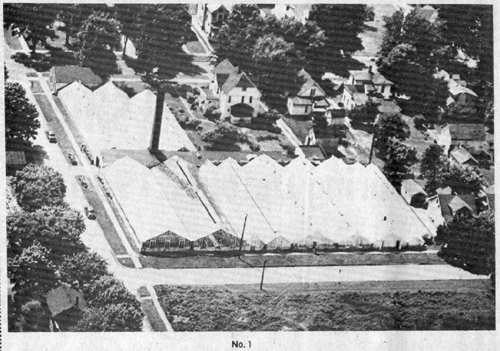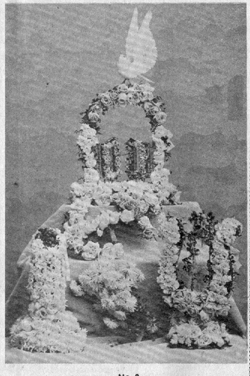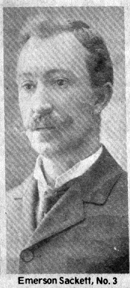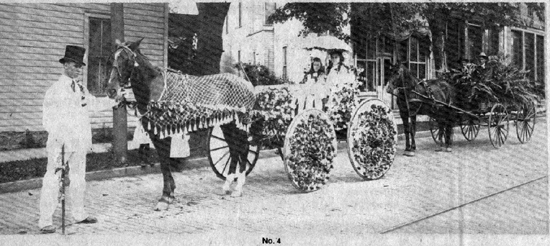October 2, 1980




Picture #1 – Shows the 13 growing houses which comprised E.R. Sackett’s Fostoria Floral Co., later called Sackett’s Greenhouse.
Picture #2 – Example of the funeral memorial of many years ago as compared with those used today.
Picture #3 – Shows two floats entered by Sackett’s in a Memorial Day parade
Picture #4 – Emerson Sackett
(Editor’s Note: Don Etchen one of many faithful readers of Potluck telephones to suggest that perhaps an article existed in the demise of greenhouses that once were in Fostoria. His interest stemmed partially from his employment at Enrights many years ago.
After considering the suggestion and writing a few paragraphs I did some further exploration of the subject, discovering there was considerable material available all of which seemed to be of the type which Potluck readers enjoy.)
Yes, what did happen to the flourishing greenhouse industry that was here in Fostoria, supplying not only this city’s need for flowers, potted plants and floral arrangements, but also supplied some of all of Northwestern Ohio.
Simply, the culprits that layed the industry low were high fuel costs and high wages, combined they caused the death. And no one thought to send flowers to those who had so faithfully supplied them for so many years.
FIRST GREENHOUSE 1880
Fostoria’s first greenhouse was established in 1880 by Black & Sackett, according to Ralph Sackett and his son Ralph Jr., the living heirs of Emerson Sackett, one of the partners of that early enterprise. The other partner was J.R. Black, but he is not listed in early directories.
According to the handbill, possessed by the Sacketts, the early business was called “Fostoria Greenhouse” and it was located near Fostoria’s Academy, but not listed.
That partnership lasted for an unknown period of time, then E.R. Sackett went in business for himself on Maple Street, back of the family residence which was at 712 N. Main.
Ironically, Sackett’s dad didn’t want him to go into the greenhouse business, but he went ahead with a contribution of $50 from his mother. And, if the business was still in operation today it would be 100 years old.
Ralph Sackett, son of the founder, continued to operate the business until July 1969, when rising costs prompted him to close the business and dismantle the greenhouses, but maintain the office area for Sackett Gift Shop, now operated by Ralph Sackett Jr. grandson of the founder.
Other growers of flowers and plants started in business in Fostoria in later years, but Sackett’s saw the signals first that escalating cost would make it difficult to continue, and they were the first here to decide to quit in 1969.
OTHERS IN BUSINESS
The other operators of greenhouses here were Enright’s on South Union Street, later taken over by Claude and Clyde Payne who came here from Missouri and took over after Tim Enright’s death. Payne Brothers continued to grow plants and flowers until a year ago, when they too were forced to stop growing. Browning Payne, a son of one of the brothers took over, he has dismantled most of the growing houses, keeping only a small area and the office to assemble floral arrangements and sell cut flowers, produced by growers out of town.
Ray Hollenbaugh started a greenhouse on Columbus Avenue many years ago, which later was bought by Charles Zumpft, still later by Mike Besserman, and today, is owned and operated by Jan & Paul’s. It now grows only a small quantity of the flowers and bedding plants, the rest of their merchandise coming from the large growers elsewhere.
According to Jan, of Jan & Paul’s, the rend is the same elsewhere, causing many of the greenhouse owners in the large cities to quit, unless they have sufficient capital to completely modernize and adopt highly competitive merchandising techniques.
Ralph Sackett and his son, better known to Fostorians as “Sonny” contributed interesting data for this article, which proved the reason E.R. Sackett, became so successful in business early in his career. He was soon rated as one of the largest growers and suppliers of flowers and potted plants in Northwestern Ohio.
SOLD DOOR TO DOOR
Back 100 years ago, when E.R. Sackett started on his own, he went door-to- door selling and taking orders. He wasn’t afraid to work, and he must have learned the rudiments of business from his father, who had a farm on Buckley Road, and from his schooling at the rural Pankhurst one-room school and later in Fostoria City Schools. He walked to school…no school buses to carry kids a few blocks then.
Sackett would work in his greenhouse all day, then go to the farm and cut wood at night to keep the growing business heated.
His next move was from Maple Street to Main and Jackson in about 1905. His business gradually expanded from three growing houses to 13, and he began to specialize in the growing of potted plants, for all holidays.
Most of the plants and cut flowers were wholesaled to other florists and flower shops in Northwestern Ohio including Toledo, Findlay, Bowling Green, Tiffin, Fremont, Kenton, Marion, Bucyrus and smaller towns.
Ralph Sackett became a business partner in 1937 and managed the business until it closed in 1969. During his active management years he was elected to the board of directors of Ohio Florists Association from 1955-1957.
TELLS EXPERIENCE
According to Ralph Sackett, few people realize the hard work, and long hours that go into the growing of flowers and planta up to the point of selling them. Every type of plant we grew was different; each had to have a different type of soil, and each took a different temperature if the very best plant was to be produced, and to have it ready on time for the particular holiday. Fighting insects was always a problem. Some cut flowers had to be cut every day, including Sundays. Potted plants needed checking every day and watered often.
We grew about five houses of poinsettias for the holidays and around 20,000 geraniums.
Years ago chrysanthemums were available only in the fall of year. Sometime around 1950, we discovered that by using artificial light on the small plants it would delay the setting of the buds, and that by shading them with black cloth it was possible to control the cycle so that we could produce them year around.
The use of artificial light also enabled us to control the poinsettias so that they would be ready just right for Christmas.
Sackett recalled during World War II it was necessary to grow vegetables plants to qualify for the purchase of coal to heat the growing houses. By 1960 they had converted the heating boilers to gas, which automated and simplified the heating problems considerably.
We were always fortunate to have good growers working for us. Most of them came to the U.S. from Germany where they studied floriculture; one of them was Mike Besserman, who worked for us for about eight years and still resides in Fostoria, according to Sackett.
PHOTOS TELL STORY
The accompanying photos are historical and educational, about an industry which has changed so much in the last 40 years and gives readers a view of one of Fostoria’s participant.
Photo #1 shows the 13 growing houses which comprised E.R. Sackett’s Fostoria Floral Co., later called Sackett’s Greenhouse. The aerial shot taken in 1954, provides a good view of the greenhouses as well as properties in that area.
Photo #2 provides an example of the funeral memorial of many years ago as companred with those used today. In this instance the memorial included three objects, made of flowers to represent death as a period in mans’ existance…(1) the broken column, in the lower left; (2) the angelic harp, in lower right; and (3) the open gates to Heaven with the dove, at top. It was just one of many photos of Sacketts, of a variety of intricate floral arrangements which were made to order many years ago.
Photo #3 shows two floats entered by Sackett’s in a Memorial Day parage back then. Ralph Sackett has no idea who the individuals are in the photo. The wheels of the buggy were covered with flowers from the Fostoria Floral Co. The second horse-drawn wagon was loaded with palms. With a magnifying glass the name Fostoria Floral Co. can be seen on the side of the second vehicle.
And what became of the second vehicle? It is still preserved in a building on the Ralph Sackett Jr. property. What will they do with it? They don’t know, but do not want to destroy it. Ralph Sackett Jr. is a collector interested in history and a member of The Lineage Society. The photo was taken on Perry Street, about opposite the old Dicken Studio.
The Stortz family had a small greenhouse across from Fountain Cemetery, catering to those who at the last minute would patronize them when arriving at the cemetery to decorate graves.
TIME CHANGES WAYS
Although many changes have taken place in the greenhouse industry, there are still a number of sources in Fostoria to by flowers, floral arrangements, plants and artificial flowers, but it is a new approach to the market compared to 40 years ago.